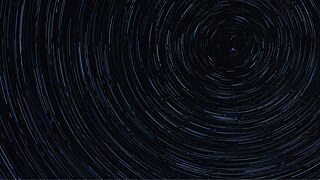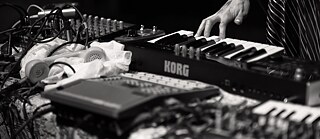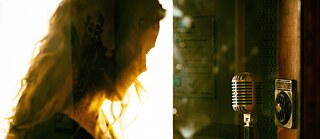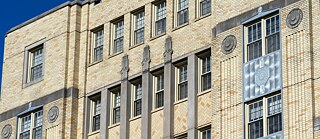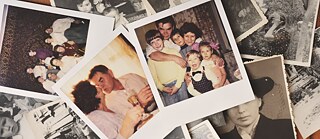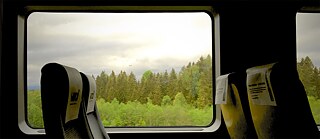Sound erleben
Listening
Bereits nach viereinhalb Monaten im Mutterleib ist unser Gehör voll ausgebildet. Von da an bestimmen Geräusche und Klänge unsere Wahrnehmung. Jim McKee spricht mit Expert*innen, die den Sound zu ihrem Beruf gemacht haben.
Diese Folge anhören: Apple Music | Spotify | Download
Diese Folge des BIG PONDER stammt von Jim McKee. Jim hat am Shenandoah Conservatory of Music und am Center for Contemporary Music des Mills College studiert. 1993 hat er Earwax Productions mitgegründet, eine Agentur für Sounddesign. In seiner Folge „Listening“ kommen Sound-Künstler*innen aus den Bereichen Radio, Theater und Film zu Wort. Die Arbeiten von Erik Bauersfeld sind im Standford’s Archive of Recorded Sound zu finden. In den 1980er- und 1990er-Jahren haben Jim und Erik für das deutsch-amerikanische Radioprojekt „Hörspiel/USA“ zusammengearbeitet. Derzeit baut Jim die Website Bay Area Radio Drama, ein Archiv für Hörspiele, aus. Der Beitrag von Walter Murch war Teil der Präsentation „Surrounded by Soundscapes“ am Berkeley Art Museum und Pacific Film Archive im August 2013. Der Bassklarinettist, den Harri Huhtamäki erwähnt, ist Tapani Rinne. Esa Karjula, Harri Huhtamäki und Rama Kolesnikow haben weitere Musik zur Folge beigesteuert. Das Foto kommt von Mike Maguire aus Washington DC. Und wer mehr über das Phänomen des Hörens erfahren möchte, findet sollte diesen Artikel des Goethe-Instituts in München lesen.
Transkript
[SOUND OF PEOPLE IN A SWIMMING POOL]
Jim McKee: The one sound that I remember emotionally was back in Ravensworth Farm where I lived in Virginia. We were up the hill, maybe four or five blocks from the swimming pool. They would have, you know, teenager night or something like that and they would ... and there would be a band playing. And so, that sound came up from down the hill. [MUSIC PLAYING] And you know, hearing that like, oh, it was like, I’m missing ... they’re having a lot of fun down there, and you know, I need to be part of that fun.
Sámara: How do you imagine sound?
[VOICES: THESE ARE GREAT HARD QUESTIONS. SOUND AND IMAGINATION, I MEAN ... / I DO IMAGINE SOUND IN ... / HOW DO I IMAGINE SOUND? / I IMAGINE IT VERY ... / I ALWAYS IMAGINE SOUND, AND THE OTHER THING IS I / IMAGINE WHAT IT MIGHT BE, ’CAUSE YOU KNOW WHAT IT IS]
Erik Bauersfeld: We did a whole series of things with West German Radio. Have you seen that folio? Didn’t Susan give that to you? I have it here. A whole project with West German Radio. It took years! Here it is.
Sámara: Erik Bauersfeld.
Erik Bauersfeld: With Klaus Schöning and all of the people at Westdeutscher Rundfunk that did radio drama. We translated, I don’t know how many, it’s all in this folio. It’s here somewhere, so I got to find that folio.
[SOUND OF PAPER RUSTLING]
Erik Bauersfeld: Maybe this one?
[SOUND OF PEOPLE IN A SWIMMING POOL]
Erik Bauersfeld: So, it must be among these.
Klaus Schöning: Listen, listen, listen, and play. Do something in your imagination and your fantasy with this, what you are listening to. So, it is on the side, the definition of the listener.
Sámara: Klaus Schöning.
Klaus Schöning: So, play. Take these sounds, take these dramas and open your imagination. Take it on and play — and [IN GERMAN] spiel.
Erik Bauersfeld: Let’s let our listeners hear what they can and play what they will with the sounds that we are so marvelously experiencing here in this exotic little spot [LAUGHING] in Big Sur. Thanks, Klaus.
Klaus Schöning: [LAUGHING] Thank you.
Erik Bauersfeld: And this was through the Goethe-Insitut. It was a whole month. [IN GERMAN] ‘Die Brücke.’
[SOUND OF A FOG HORN]
Woman: [IN GERMAN] Die Brücke?
Erik Bauersfeld: Yes, ‘The Bridge.’ [SOUND OF A FOG HORN] The bridge between Germany and
America in radio.
Woman: Oh, that’s ... Okay, I see.
Erik Bauersfeld: See, this is the Golden Gate Bridge. I designed this. And this is the Dome. And here’s Klaus and the Goethe-Institut and me and this fellow translated the plays. Hörspiel/USA, we called it.
[SOUND OF PAPER RUSTLING, SEAGULLS, AND A FOG HORN]
Erik Bauersfeld: And it went on throughout the month. We did a few more and then went nationally.
Announcer: [IN GERMAN] Westdeutscher Rundfunk, drittes Programm.
Bill Fontana: At that time, I was involved with developing a project in San Francisco for SFMOMA for the 50th anniversary of the Golden Gate Bridge.
Sámara: Sculpture soundscapes.
Bill Fontana: That was called Sound Sculptures through the Golden Gate.
Sámara: Bill Fontana.
Bill Fontana: And what that was gonna be a live duet between the Golden Gate Bridge and the Farallon Islands National Wildlife Refuge, which is a seabird colony, 30 nautical miles directly west of the Golden Gate Bridge. Klaus became very interested in this and decided that we would revisit the piece I’d done in 1985 with Metropolis Cologne and basically do a live duet between the city of Cologne and the sounds of Cologne and San Francisco with the Golden Gate Bridge and the Farallon Islands.
[SOUND OF CHURCH BELLS AND SEAGULLS]
Erik Bauersfeld: You know the kinds of question. We were talking about the acoustic imagination in many ways. Every art has its imagination, and no art is more imaginative than any other art. Imagination is everywhere. There’s a particular thing that we’re interested in, which is: what is acoustical imagination — and how it works. And this has come up in many forms: in the ability to listen and the ability to hear things that other people don’t hear. All artists do that. I mean, visual artists, dance artists know movement, sound — more in ways than other people.
[SOUND OF BIRDS AND CRICKETS]
Jim McKee: As a child, I spent a ton of time in the woods. Get up, you know, at the crack of dawn and then head down to the creek and follow the path down to the lake where I’d fish. And the woods are still there. And the path is still there. It’s as strong as a memory that you get with smell as to the sounds and the insects and the birds, and it just takes you back.
Erik Bauersfeld: When I was very small, I listened to radio when it first began, and it was a wonder to be able to hear the voices that came from outside your own house. And early radio here in America was very rich. It was all kinds of things.
[MUSIC PLAYING]
Erik Bauersfeld: And they had a lot of children’s programs, and it didn’t too much matter whether the script was brilliant or the acting was ... [VOICE BECOMES DISTANT] Even sound didn’t have to be very profound, you know. One, there was something called Buck Rogers in the 25th Century. It was science fiction even in the — when was this? The ’30s? [VOICE BECOMES DISTANT] Way back. And they had all the space things and all the things that we now have, and you could imagine them. They had something called a ‘psychic restriction ray,’ which if you shot it at someone, it went bzzzzz — like that. [VOICE BECOMES DISTANT] Just like that. That’s all. But you saw it, you imagined it. You went all over the world on these things. Outer space, everywhere. And this was new. Totally new. Not exactly, we did it in play. We played games in the ’20s — early ’20s — and those games often had to do with all kinds of adventures. [VOICE BECOMES DISTANT] Space travel. They were things we made up. [VOICE BECOMES DISTANT] Ships at sea. And so, that was imaginative play. But then, to hear it, stimulate it, not by your friends in the street and your imagination but by another source of imagination.
Walter Murch: We are conceived. We develop in the womb, and four and a half months after conception, the hearing switch is turned on.
[SOUND OF A HEART BEATING]
Sámara: Walter Murch.
Walter Murch: Sight is not turned on. We live in darkness in the womb. Smell is not operative in the womb. Touch is a kind of a slippery mucal feeling, but hearing is as fully articulated at four and a half months as it will be later. So, the child developing in the womb is a fully auditory creature. And so, each of us in this room was born into consciousness. The developing fetus is a conscious being, developing a sense of the self and the world, such as it is in the womb. All through the process of hearing.
[SOUND OF A BABY CRYING]
Walter Murch: When you’re born, these other senses kick on. Primarily sight and you start to begin to develop this idea that the sound is caused by something. Your mother comes in, and you start to see these strange things called lips beginning to move, and the voice that you have heard in the womb comes out of these lips. And you begin to say, Oh, that’s what made the voice.
[VOICES: OH YEAH / WHAT WAS THE FIRST SOUND I REMEMBER ... / OH MAN / IT’S SO HARD TO REMEMBER WHEN THINGS OCCUR / I REMEMBER / A SOUND OF / I MEAN / MY MOM’S GUITAR / THAT’S A WEIRD ONE / THE FIRST SOUND THAT REGISTERED FOR ME WAS MY MOTHER’S VOICE]
[MUSIC PLAYING]
Susan Stone: First sound I remember: our blinds, window blinds slapping against the glass.
Sámara: Susan Stone.
[WOMAN SINGING]
Susan Stone: I lived in a room that faced a windy hill, and the wind hitting those blinds would always put me to sleep at night and always wake me up. And it was a very soft sound. Very rhythmic. And very comforting.
Sámara: Word soundscapes.
[SOUNDSCAPE]
Susan Stone: I do imagine sound in slightly different ways, possibly because in becoming a maker of sound and engineering it, I often would think of it in terms of shape or depth or light or weight. I wanted the sound to inform but also to become a story within a story. If there was sound that was just casual ambient sound, did it lead to something? Did it inform something? Was it a message of some sort? And that drew me increasingly to the linguistic landscape of the South where sound often took the most profound shape in terms of how people vocalized. So for me, sound became a certain kind of storytelling, and taking storytelling even further was seeking out how the voice is music, how the voice could be percussive.
Bobbie Davies: Hmm. The first sound I remember, like going back ... An early sound in my life I think of a lot is singing in assembly programs at school.
[MUSIC — “WHITE CORAL BELLS”]
Bobbie Davies: Third, fourth grade. I remember the sound and the feeling of being in a room with a couple hundred other children and singing together. And it’s around, and they’d divide us up, and it was just wonderful to be immersed in this world of, I guess, all soprano voices. That comes back to me every once in a while. I still remember it.
[SOUNDSCAPE]
Sámara: Bobbie Davies.
Bobbie Davies: Oh, I hear sound.
Sámara: Theater soundscapes.
Bobbie Davies: For me, the sound is a character. It’s part of the way we tell the story in theater and in films. It’s a way of work in service of what is going on. Sometimes, it’s something physical: somebody shoots a gun, and you wanna make a sound. [VOICE BECOMES DISTANT] Kind of windy spooky sound. But a lot of times ... [VOICE BECOMES DISTANT] Occasionally ... You’re out there, and you are thinking: okay, [VOICE BECOMES DISTANT] ringing: we just ended a scene. [VOICE BECOMES DISTANT] Buzzes: going to a new scene. What do I want to do? Oh yeah! Bring it to a close? Do I wanna introduce the next scene? [VOICE BECOMES DISTANT] Now, it’s calmer. Do I wanna have a transition that morphs from the one scene to the other? [VOICE BECOMES DISTANT] Oh, bell-like sounds. You’ve got these decisions that are basically not sonic but dramatic. My vision of what a sound would be starts from that. [VOICE BECOMES DISTANT] You could put wheels in this, and they’d fit right in.
Ronnie Brown: A very, very prominent sound in my memory growing up is the sound, what I call ‘The Saturday.’
[SOUNDSCAPE]
Ronnie Brown: It is the sound of woodworking tools from my neighbors, the sound of lawn mowers, just a constant buzz of lawn mowers, and cows mooing on the hillside around the corner from where I lived. And all of those things kind of combined. I have vivid memories of sitting in a tree, kind of listening to all of these unfold every weekend. And it was always the same, and it brings me — I can smell it. I can feel the sun. I can feel the breeze. I can transport myself just from the sheer repetition and striking memory of that experience of those sounds.
Sámara: Ronnie Brown.
Ronnie Brown: I am very tactile. I’m a tactile person. My sister was the one holding the hose, and I was the one getting muddy in the dirt.
Sámara: Foley artist.
Ronnie Brown: I feel, I touch, and I touch things in a lot of ways. I am that funny person that’s on the street that I see something on the street corner that someone might have thrown out, and I kind of give it a kick at first to kinda hear what it does and what it sounds like. And then if that intrigues me, I kind of go for more. And so, I kind of bend down, and I put my hands on it and tap it a little bit harder, softer. What does it feel like? Is it smooth, is it rough? What can it give me?
[SOUNDSCAPE]
Sámara: Haptic soundscapes.
Ronnie Brown: John and Mary are going to meet for a coffee in a diner. And they’re walking into the diner right now. So, I hear a door open. [DOORBELL RINGS] That is gonna be covered by effects. [PEOPLE TALKING] So now, I am concentrating on Mary’s footsteps because she walks in first. She seems like she is dressed in something that might be somewhat business, might be somewhat dressy. So, I am going to assume that she is in heels. We don’t see them, so it’s up to the artist’s imagination. [SOUND OF WALKING IN HEELS] I see the outfit, and to me, it makes sense to have her in some sensible heels. The surface in the diner seems to me like it would be some sort of linoleum over concrete. So, I would probably keep that the entire way from the door in to the table. [SOUND OF SITTING DOWN ON A CHAIR] John on the other hand, is coming from a [SIC] exercise. So, I’m probably going to put him in some sneakers. [SOUND OF WALKING IN SNEAKERS] When they sit down, the banquettes are leather, so we’ll have a really nice slide and a really nice leather creak for them to kind of get them settled in to having their coffee together. One for Mary, one for John. The Formica table is going to be where I am going to see them put their hands, their keys, their cellphones, and everything [SOUND OF KEYS] and also their coffee cups. [SOUND OF PORCELAIN] So, the waitress will come, she’s probably in some sensible shoes ...
[SOUNDSCAPE]
Randy Thom: I was the sound designer on several projects Erik and Klaus produced together.
Sámara: Randy Thom.
Randy Thom: I do think a lot about emotional notes within sounds.
Sámara: Film soundscapes.
Randy Thom: [VOICE BECOMES DISTANT] I guess that’s what I’m trying to imagine. My approach to designing is always to experience a thing. [VOICE BECOMES DISTANT] I think in terms of what is this sound like, then react intuitively to it without much analysis. [VOICE BECOMES DISTANT] I’m looking for sinister sounds, comical sounds. The thing I am reacting to may be a script or an idea or an image or a sound. [VOICE BECOMES DISTANT] Interestingly-spaced sounds. I tend to be very analytical about the role of sound in media but not very analytical about ... [VOICE BECOMES DISTANT] All the sounds themselves. Ambiguous sounds. One that stretches the audience’s imagination a little bit.
Erik Bauersfeld: Creative imagination is rooted ... It’s wonderful to be able to hear people the way they are and know that they have something to say and an attitude. To hear the voice of the poets and the writers, dramatists, great performers. Performers, by the way, it’s another ... radio is a performance art, too.
[SOUNDSCAPE]
Sámara: Data soundscapes: The Hub.
Scott Gresham-Lancaster or Phil Stone: Yes. Hot Potato, this recording — is this from the 3-CD set?
Sámara: Scott Gresham-Lancaster and Phil Stone.
Scott Gresham-Lancaster or Phil Stone: We’re at the conservatory in Cuneo, Italy, and we’re playing in this kind of cathedral space, and we spent like five days with these students playing with Hot Potato. So, Hot Potato is based on the childhood game that you’d pretend a bean bag is really hot. And you’d catch it. And then, you gotta to throw it very fast. And so, you had 400 milliseconds to throw the note. [LAUGHS] And you can throw it to anybody. And so, just like, you’d get a note. And you’d play the note. And then, you’d throw the note, you know. And we would do this thing where it would just go like, brrackkk, and just like throw out — like, you know, 50 notes. And then, you know, a lot of people’s code was broken, so like 25 notes would go away immediately, and then there’d be 25 notes like pinging around the ... It was just basically kind of like Conway’s Game of Life. It was like ... And the ‘ur-piece’ like this at The Hub is something called Wax Lips. And so, that’s what was going on with that piece.
Erik Bauersfeld: I grew up liking it, and when I started writing, I wrote radio plays. Now listen, radio in America was fantastic in those days. Great! Writers, wonderful performers, talents, everything from humor and soap operas to serious dramas. I heard my first Ibsen listening on a little radio, a Philco radio. So, it was an awakener to the dramatic arts and to an outside world.
Andrew Roth: Hi.
Radio Announcer: Good evening, everybody. You are now listening to WLS, the voice of Prairie Farmer Chicago.
[RECORD PLAYING MUSIC AND PEOPLE TALKING]
Andrew Roth: My father started taking me to Tower Records when I was probably five or six. And we’d go straight to the Beatles section, and I’d get a Beatles LP. Somehow, I drifted over to the cassette room, and there were these bargain-basement cassette bins of Abbott and Castello and the Green Hornet and, you know, more obscure ones, Fibber McGee and Molly. Strange stuff and I don’t know why a small child would be attracted to that. I mean, they were laughing and doing the “Who’s on first?” kinda stuff, but I remember all the in-between stuff. It was like a little window into the past. The music, the interstitials, the commercials for Lux Flakes. That’s, I guess that’s pretty early.
Sámara: Andrew Roth.
Andrew Roth: One incredibly rewarding project that I’ve done is this recreation of Market Street in San Francisco at a particular location in 1906 right before the famous earthquake and fire.
[STREET SOUNDS]
Sámara: Archeological soundscapes.
Andrew Roth: There’s a well-known film going down Market Street at that time, just days before the earthquake. You see bicyclists and kids and cops and horses, and you see the whole sort of slice of life. But of course, there’s no sound. So, I’ve always been interested in ... What does that feel like to be there? It’s one thing to see a black-and-white movie, but for me, as I said, sound just takes me to a place, and so I wanted to go to that place. Up until fairly recently, the technology wasn’t there unless you had a million dollars, and you could actually hire horses and old cars and actors, and then find a space as large as the intersection of Kearney and Market, and then just re-create the whole thing. And record it with a binaural head. But now, with the way that computers are, the processing power ... I thought, well, I could actually record all of those things I’m seeing individually. The real ones, the authentic ones. That car. That two-stroke engine. The cable cars I’m seeing. How would they sound the same or different than the cable cars we have now in San Francisco? Put that whole thing in a computer, and then in a three-dimensional space, start moving all the objects around you, and see what that would sound like.
[RECORD PLAYING: THIS IS JEREMIAH. AND WE’VE JUST ARRIVED AT THE TANK FROM OUTSIDE]
Jeremiah Moore: I grew up hearing of this acoustic place called The Tank, which was in a mysterious location and seemed to be a place that only certain people were invited to, and this was very attractive to me. I’d heard some music from there that just sounded angelic and amazing. People would go in and sing and play instruments, and it would reverberate for ...
[LOUD VIBRATING SOUND, FOLLOWED BY MUSIC]
Jeremiah Morre: Oh, a long time and allow the people that were there to kind of paint in space and paint in time with their voices and with the sounds that they were making.
Sámara: Jeremiah Morre.
Jeremiah Morre: So, there’s this effect where you sing a note. And then, while it’s ringing, you sing another note, and you can make chords. And you become part of the space, and the space becomes part of you.
Sámara: Architectural soundscapes.
Jeremiah Morre: And it really is a different way of making sound to be enmeshed in the close loop of carefully listening to everything you do.
Jim McKee: Take it, John.
Harri Huhtamäki: For me, it’s very hard to say what’s the relationship between imagination and sound.
Sámara: Harri Huhtamäki.
Harri Huhtamäki: But anyhow, these soundscapes, they are creating ...
[FINNISH RADIO]
Harri Huhtamäki: ... mindscapes in listener’s mind.
Sámara: Mindscapes.
Harry Huhtamäki: And the constant dialogue between soundscapes and mindscape, that’s the most important thing. If they don’t create any dialogue, then it’s not worth of listening.
Sámara: Mindscapes.
Harri Huhtamäki: The soundscapes are suggesting all the time something to the listener, which he or she doesn’t expect. So it’s kind of a ... giving suggestions, surprises all the time. Imagination in a listener’s head. You are creating tensions, expectations, suggestions where a listener could say that something is happening. But you don’t know what it is. Or do you, Mr. Jones?
[“MOTHER, ALZHEIMER AND AMERICANA” PLAYING]
Harri Huhtamäki: The beginning of the program called Mother, Alzheimer and Americana, I wanted to create in the beginning kind of a mood of soundscape, which is a bit gloomy, giving the idea of the Alzheimer-disease experienced by the person who has it, to kind of a, or might be, a kind of a prison feeling. In the beginning, Tapani Rinne is playing the bass clarinet. Real low. Sensitive. Blowing and breathing at the same time. And then, you hear some chains falling on the floor, giving kind of a, maybe the hint of being in the prison, but you’re not quite sure. And then, my mother is calling and saying, Come and take me home. Although she is calling from her own home.
[TELEPHONE SOUNDS]
Harri Huhtamäki: One of the first sounds in my childhood was when I was visiting my grandparents, and in their neighborhood, there was a [SIC] old uncle, and he had a mandolin in his living room’s wall, and I asked him, Can I play with that? And he tuned it, and then, I picked a couple of sounds and was really happy, I can play ...
[GUITAR PLAYING]
Jeremiah Moore: I’ve been personally defensive about my child imagination capacities and try to keep them. I find that imagination can be a way of being real and honest and open to things. I don’t know what happens to it. I think that, I hope that, I think that, maybe I think that it doesn’t disappear, it’s just that you have to find how to access it. Sometimes, the paths in get a little bit grown over or crowded. But you can find them if you try or maybe if you stop trying in just the right way.
[SOUND OF PEOPLE IN A SWIMMING POOL]
Klaus Schöning: Yeah, open your ears and listen a bit. I think we can call this, what we’ve just listened, a ‘Hörspiel.’ In any situation in which you are, if you open your ears. It’s very strange, our ears are always open because we have not eyelid ... We have no ear ... What do we call this? [IN GERMAN] Ohrenlider. We have [IN GERMAN] Augenlider? We can close the eyes ...
Erik Bauersfeld: We close the eyes. We have no ‘ear lids.’
Klaus Schöning: We have no ear lids. This is very strange, otherwise we close our ears sometimes, and we don’t listen mostly to the sounds and to the life, to the acoustic life around us. And so, I think we can call this a Hörspiel.
Erik Bauersfeld: Why don’t we just listen — and hear ... [LAUGHS] A Hörspiel.
Klaus Schöning: [LAUGHS] And play. And play.
Erik Bauersfeld: And play, yeah.
Klaus Schöning: Make a Hörspiel.

